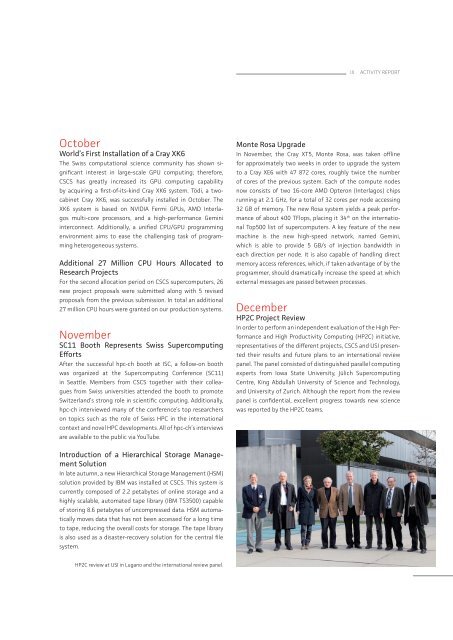Annual Report 2011 - CSCS
Annual Report 2011 - CSCS
Annual Report 2011 - CSCS
You also want an ePaper? Increase the reach of your titles
YUMPU automatically turns print PDFs into web optimized ePapers that Google loves.
October<br />
World’s First Installation of a Cray XK6<br />
The Swiss computational science community has shown significant<br />
interest in large-scale GPU computing; therefore,<br />
<strong>CSCS</strong> has greatly increased its GPU computing capability<br />
by acquiring a first-of-its-kind Cray XK6 system. Tödi, a twocabinet<br />
Cray XK6, was successfully installed in October. The<br />
XK6 system is based on NVIDIA Fermi GPUs, AMD Interlagos<br />
multi-core processors, and a high-performance Gemini<br />
interconnect. Additionally, a unified CPU/GPU programming<br />
environment aims to ease the challenging task of programming<br />
heterogeneous systems.<br />
Additional 27 Million CPU Hours Allocated to<br />
Research Projects<br />
For the second allocation period on <strong>CSCS</strong> supercomputers, 26<br />
new project proposals were submitted along with 5 revised<br />
proposals from the previous submission. In total an additional<br />
27 million CPU hours were granted on our production systems.<br />
November<br />
SC11 Booth Represents Swiss Supercomputing<br />
Efforts<br />
After the successful hpc-ch booth at ISC, a follow-on booth<br />
was organized at the Supercomputing Conference (SC11)<br />
in Seattle. Members from <strong>CSCS</strong> together with their colleagues<br />
from Swiss universities attended the booth to promote<br />
Switzerland’s strong role in scientific computing. Additionally,<br />
hpc-ch interviewed many of the conference’s top researchers<br />
on topics such as the role of Swiss HPC in the international<br />
context and novel HPC developments. All of hpc-ch’s interviews<br />
are available to the public via YouTube.<br />
Introduction of a Hierarchical Storage Management<br />
Solution<br />
In late autumn, a new Hierarchical Storage Management (HSM)<br />
solution provided by IBM was installed at <strong>CSCS</strong>. This system is<br />
currently composed of 2.2 petabytes of online storage and a<br />
highly scalable, automated tape library (IBM TS3500) capable<br />
of storing 8.6 petabytes of uncompressed data. HSM automatically<br />
moves data that has not been accessed for a long time<br />
to tape, reducing the overall costs for storage. The tape library<br />
is also used as a disaster-recovery solution for the central file<br />
system.<br />
HP2C review at USI in Lugano and the international review panel.<br />
III ACTIVITY REPORT<br />
Monte Rosa Upgrade<br />
In November, the Cray XT5, Monte Rosa, was taken offline<br />
for approximately two weeks in order to upgrade the system<br />
to a Cray XE6 with 47 872 cores, roughly twice the number<br />
of cores of the previous system. Each of the compute nodes<br />
now consists of two 16-core AMD Opteron (Interlagos) chips<br />
running at 2.1 GHz, for a total of 32 cores per node accessing<br />
32 GB of memory. The new Rosa system yields a peak performance<br />
of about 400 TFlops, placing it 34th on the international<br />
Top500 list of supercomputers. A key feature of the new<br />
machine is the new high-speed network, named Gemini,<br />
which is able to provide 5 GB/s of injection bandwidth in<br />
each direction per node. It is also capable of handling direct<br />
memory access references, which, if taken advantage of by the<br />
programmer, should dramatically increase the speed at which<br />
external messages are passed between processes.<br />
December<br />
HP2C Project Review<br />
In order to perform an independent evaluation of the High Performance<br />
and High Productivity Computing (HP2C) initiative,<br />
representatives of the different projects, <strong>CSCS</strong> and USI presented<br />
their results and future plans to an international review<br />
panel. The panel consisted of distinguished parallel computing<br />
experts from Iowa State University, Jülich Supercomputing<br />
Centre, King Abdullah University of Science and Technology,<br />
and University of Zurich. Although the report from the review<br />
panel is confidential, excellent progress towards new science<br />
was reported by the HP2C teams.<br />
13


